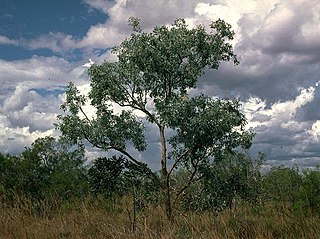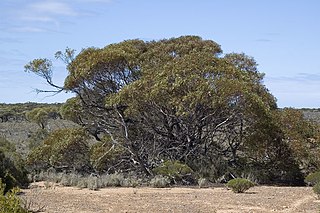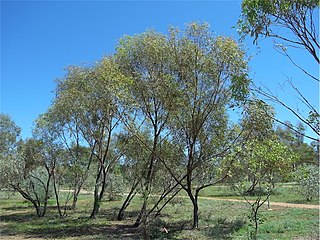
Eucalyptus victrix, commonly known as the smooth-barked coolibah, western coolibah or little ghost gum, is a species of small tree that is endemic to Australia. It has smooth bark, lance-shaped to curved adult leaves, flower buds in groups of seven, creamy white flowers and conical fruit.

Eucalyptus intertexta, commonly known as inland red box, western red box, gum coolibah or the bastard coolibah, is a species of tree that is endemic to central Australia. It has rough, fibrous or flaky bark on the base of the trunk, smooth white to brownish bark above, lance-shaped adult leaves, flower buds in groups of seven on the ends of branchlets, white flowers and cup-shaped to hemispherical fruit.

Eucalyptus magnificata, commonly known as blue box or northern blue box, is a species of small tree or sometimes a mallee that is restricted to a small area of New South Wales. It has rough, fibrous or flaky bark on the trunk and larger branches, smooth bark above, broadly lance-shaped to egg-shaped leaves, flower buds in groups of seven, white or pale yellow flowers and conical fruit.

Eucalyptus argillacea, commonly known as Mount House box, or northern grey box is a tree that is endemic to northern Australia. It has rough, fibrous bark, lance-shaped adult leaves, flower buds usually in groups of seven, creamy white flowers and conical fruit.
Eucalyptus limitaris is a species of tree or mallee that is endemic to north-west Australia. It has rough, flaky or fibrous bark on the trunk and branches, lance-shaped to curved adult leaves, flower buds in groups of seven on a branching peduncle and conical to barrel-shaped or cup-shaped fruit.

Eucalyptus lucens, commonly known as the shiny-leaved mallee, is a species of mallee that is endemic to northwestern Australia. It has small, pale greyish to brown bark, glistening, lance-shaped adult leaves, flower buds in groups of seven on a branching peduncle, creamy white flowers and conical fruit.

Eucalyptus mannensis, commonly known as Mann Range mallee, is a species of mallee that is native to Western Australia, South Australian and the Northern Territory. It has rough bark at the base of the trunk, smooth bark above, narrow lance-shaped adult leaves, flower buds in groups of between seven and eleven, creamy white flowers and hemispherical fruit.
Eucalyptus obconica is a species of small tree or a mallee the is endemic to the Kimberley region of Western Australia. It has rough fibrous or flaky, wavy bark on the trunk and branches, lance-shaped to curved or oblong adult leaves, flower buds in groups of seven, white flowers and conical fruit.

Eucalyptus oligantha, commonly known as the broad-leaved box, is a species of tree that is native to the Kimberley region of Western Australia and parts of the Northern Territory. It has rough, fibrous or flaky greyish bark, broadly egg-shaped to almost round adult leaves that are lost in the dry season, flower buds in groups of three or seven, creamy yellow to whitish flowers and cup-shaped to more or less cylindrical, bell-shaped or conical fruit.

Eucalyptus platycorys, commonly known as Boorabbin mallee, is a species of mallee, rarely a small tree, that is endemic to Western Australia. It has rough, dark grey, fibrous and flaky bark on the trunk, smooth greyish bark above, lance-shaped adult leaves, flower buds usually in group of three, creamy white flowers and cup-shaped to cylindrical fruit.

Eucalyptus pruinosa, commonly known as silver box, silver leaf box, apple box or smoke tree, is a species of tree or a mallee that is endemic to northern Australia. The Jaminjung peoples know the tree as yarrirra or jarnbiny, the Jaru as wararn and the Wagiman as wararn. It has rough, fibrous to flaky bark on the trunk and branches, a crown composed of juvenile, glaucous, heart-shaped to broadly elliptical leaves arranged in opposite pairs, flower buds arranged in groups of seven on the ends of branches, creamy white to pale yellow flowers and cylindrical to conical fruit.

Eucalyptus sparsa, commonly known as the northern ranges box, is a species of mallee that is endemic to inland Australia, near the border between the Northern Territory, South Australia and Western Australia border. It has smooth pale grey and brown bark, often with rough bark on the base of larger trunks, lance-shaped adult leaves, flower buds usually in groups of seven, white flowers and shortened spherical to conical fruit.

Eucalyptus tetrodonta, commonly known as Darwin stringybark or messmate, is a species of medium-sized to tall tree that is endemic to northern Australia. It has rough, stringy or fibrous bark on the trunk and branches, lance-shaped leaves arranged in opposite pairs, flowers buds in groups of three, whitish to cream-coloured flowers and cylindrical fruit.
Eucalyptus xerothermica is a species of mallee or a tree that is endemic to northern Western Australia. It has rough, fibrous or flaky bark on the trunk and branches, lance-shaped to curved adult leaves, flower buds in groups of three or seven, creamy white flowers and conical to barrel-shaped fruit.

Eucalyptus yalatensis, commonly known as the Yalata mallee, is a species of mallee or a shrub that is endemic to southern Australia. It has rough, fibrous or flaky bark on the stems, smooth bark above, lance-shaped adult leaves, flower buds mostly in groups of nine, creamy white or yellowish flowers and hemispherical to shortened spherical fruit.

Corymbia collina, commonly known as the silver-leaved bloodwood, is a species of tree that is endemic to Western Australia. It has thin patchy rough bark on some or all of the trunk, smooth white to pale grey bark above, lance-shaped to curved adult leaves, flower buds in groups of seven, creamy white flowers and barrel-shaped fruit.
Eucalyptus costuligera is a species of small tree that is endemic to the Kimberley region of Western Australia. It has short-fibrous or flaky bark on the trunk and branches, bluish, lance-shaped adult leaves, club-shaped flower buds in branched or unbranched inflorescences with the buds in groups of up to seven, creamy-white flowers and conical, cup-shaped or pear-shaped fruit.

Eucalyptus distans, commonly known as the Katherine box, is a species of small tree that is endemic to northern parts of Australia. It has rough, fibrous grey bark, dull, narrow lance-shaped adult leaves, flower buds in groups of seven, creamy white flowers and cup-shaped to hemispherical or conical fruit.

Eucalyptus normantonensis, commonly known as Normanton box, is a species of mallee, rarely a small tree, that is endemic to northern Australia. It has rough, fibrous or flaky bark on some or all of the stems, lance-shaped to curved adult leaves, flower buds in groups of between seven and eleven, white flowers and cylindrical, barrel-shaped or shortened spherical fruit.

Eucalyptus socialis subsp. eucentrica, commonly known as the inland red mallee, is a subspecies of mallee that is endemic to inland Australia. It usually has rough bark on the base of the trunk, smooth bark above, lance-shaped adult leaves, flower buds in groups of between seven and eleven, pale creamy yellow flowers and barrel-shaped to urn-shaped or spherical fruit.
















